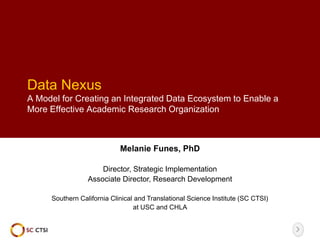Data Nexus: Enabling a more effective academic research organization
- 1. Data Nexus A Model for Creating an Integrated Data Ecosystem to Enable a More Effective Academic Research Organization Melanie Funes, PhD Director, Strategic Implementation Associate Director, Research Development Southern California Clinical and Translational Science Institute (SC CTSI) at USC and CHLA
- 2. Data Nexus development team Planning, Evaluation and Tracking o Melanie Funes, PhD Director, Strategic Implementation o Eun Evans, PhD Project Manager o Annie Hong, BS Program Coordinator o April Bagaporo, BS Program Coordinator eHome: Digital Innovation o Katja Reuter, PhD Director, Digital Strategy and eHome o Praveen Angyan, MS Technical Lead o Bruce Park, MS Web Developer o Ed Ward Web Developer o John Burgos, MS Project Manager
- 3. The CTSA Evaluation Unit challenge o Demonstrate value in a concrete way to stakeholders o Introduce approaches to create a strategic organization o Increase alignment between program and institute priorities o Provide support to develop goals, target and metrics of success o Assess progress toward goals and targets o Develop strategies and approaches to improve performance o Build tools and best practices to achieve excellence o Enable data-driven decision making
- 4. At the end of the dayŌĆ”it all comes down to ŌĆ”Use, Cost, Quality, Outcomes, Impact o How we measure and track it (innovation) o How we use the data (decision making, continuous improvement)
- 5. NCATS, we have a problemŌĆ” Apollo 13 Liftoff www.hq.nasa.gov/office/pao/History/alsj/a13/ap13-KSC-70PC-160HR.jpg
- 6. ŌĆ”connecting the data dots The right data at the right time is crucial o Actionable insight o Informs course correcting decisions o Adjust service provision (maximize resources ŌĆō minimize costs)
- 7. ŌĆ”connecting the data dots Activities Individuals We need critical data connections o Activities + Individuals + Outcomes Outcomes
- 8. ŌĆ”connecting the data dots Data Nexus, a technical solution o Automated data aggregation from multiple sources
- 9. ŌĆ”connecting the data dots Data Nexus, a technical solution o Automated data aggregation from multiple sources o Subsequent data distribution across multiple outputs
- 10. ŌĆ”connecting the data dots to create a Data Ecosystem for tracking use, cost, quality, outcomes, and impact
- 11. Data Nexus an integrated Data Ecosystem INFORMATION INPUT SYSTEMS (Investigators, Services, Outcomes) Consultation Services Tracker SC CTSI ŌĆ£Get Expert AdviceŌĆØ Collect Investigator Information Formstack: Online Form Builder Track Service Provision HelpSpot: Service Tracking System Program Activity Tracker SC CTSI Intranet Collect Activity Information Formstack: Online Form Builder e-GATE Pilot $ and K/T Tracker INFORMATION OUTPUT SYSTEMS Service Invoicing Zoho: Business Invoicing Application Service Reports Performance Management ClearPoint Strategy: Balanced Scorecard Software Communication Real-time updates Web syndication Validation Satisfaction Survey Databases Progress Reporting Survey System Service Agreement External: PubMed eRA iEdison News Internal: C&G Kuali iStar OTT HR Datafeed
- 12. A data ecosystem is crucialŌĆ” ŌĆ”but not enough for a long lasting culture-shift in decision-making
- 13. Of more importanceŌĆ” New approaches + Training + Trust
- 14. The possibilities are endlessŌĆ” o Oakland AŌĆÖs (Billy Beane) + Bill James (stats) o Laser focus on winning o 2003: Run vs walk? DoesnŌĆÖt matter (on-base %) o Outcome: Winning team with less money o ŌĆ£Stats revolution that changed baseballŌĆØ Joe Delessio
- 15. The possibilities are endlessŌĆ” o 2003 ŌĆō budget deficit and on the decline o Underestimating core business and strengths o DidnŌĆÖt understand where they were making $ o Data + operational focus + forecasting needs o WorldŌĆÖs largest toy manufacturer
- 16. The possibilities are endlessŌĆ” o Track o Analyze o Predict o Succeed by giving people what they want
- 17. The possibilities are endlessŌĆ” o Mission ŌĆō Predict, measure, and improve the return on social investments o Use data to develop strategies to move the needle on intended outcomes www.missionmeasurement.com
- 18. What can CTSAs do next with dataŌĆ” ŌĆ”to enable new data-driven decision making models for academia? ŌĆ”to better understand ourselves? ŌĆ”to identify our unique strengths? ŌĆ”to measure and articulate our impact? ŌĆ”to predict success of our clinical and translational research portfolios? ŌĆ”to strategically invest and do more with less?
- 19. Thank You SC CTSI | www.sc-ctsi.org Phone: (323) 442-1251 Email: melanie.funes@usc.edu
Editor's Notes
- #12: Seeded with APR Yr1-4



















